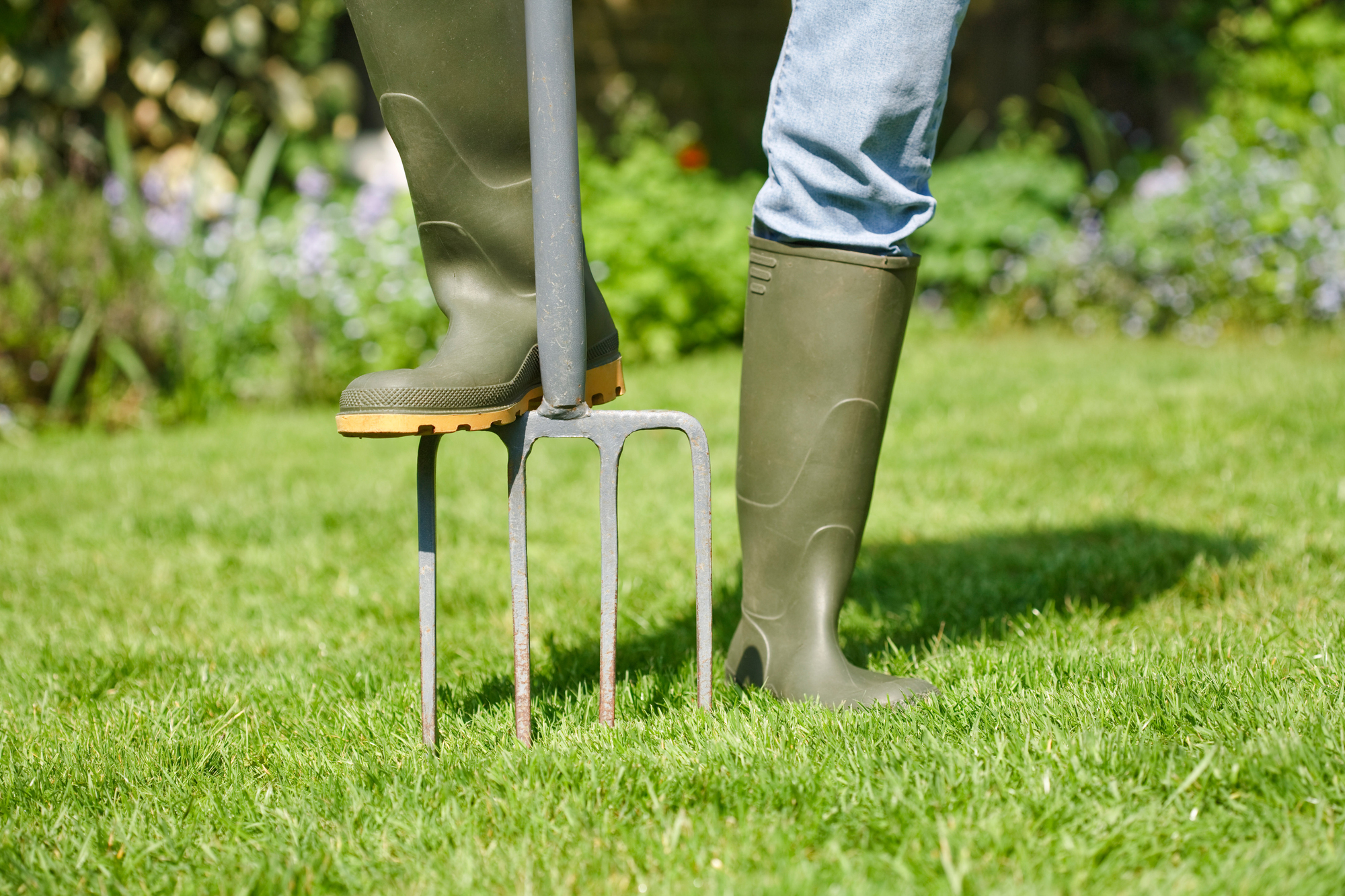As summer approaches, maintaining a beautiful lawn requires early preparation. Taking care of essential lawn maintenance tasks before the season begins helps ensure your garden stays healthy and vibrant throughout the warmer months. Proper lawn preparation in spring creates a strong foundation for summer growth and helps prevent common problems like weeds, patchy grass, and disease.
Getting ahead with lawn care before summer arrives saves time and effort later. Rather than dealing with issues after they’ve developed, preventative maintenance can establish optimal growing conditions for your grass. These pre-summer tasks establish the groundwork for a lush, green lawn that will be the envy of your neighbourhood when summer is in full swing.
1) Scarify to remove thatch buildup
Thatch is a layer of dead grass, roots and debris that builds up between the soil and the green grass blades. When this layer becomes too thick, it prevents water, nutrients and air from reaching the soil and grassroots.
Scarifying your lawn involves removing this thatch layer to keep your grass healthy. The best time to scarify is during spring, before summer heat arrives, when the grass is actively growing and can recover quickly.
For small lawns, a hand rake can be effective for removing thatch. Larger areas might require a mechanical scarifier, which can be hired from most garden centres.
Work in one direction first, then make a second pass at right angles to ensure thorough coverage. The lawn may look somewhat bare after scarifying, but this is normal.
After scarifying, clear away the removed thatch and consider overseeding any sparse areas. This process helps your lawn absorb more water during summer months and reduces the risk of drought damage.
2) Apply spring fertiliser with a high nitrogen content
Spring is the perfect time to add fertiliser to your lawn. Choosing a spring fertiliser with high nitrogen content helps promote vigorous leaf growth and gives your grass the nutrients it needs to develop a lush appearance.
Nitrogen is essential for chlorophyll production, which gives grass its green colour. When applied in spring, it helps grass recover from winter dormancy and prepares it for the warmer months ahead.
The best time to apply spring fertiliser is late April to early May when the soil has warmed up. This timing allows the grass to take full advantage of the nutrients during its active growth phase.
Follow the application rate recommended on the product packaging. Using too much can burn your lawn, while too little won’t provide adequate nutrition.
Water your lawn thoroughly after applying fertiliser to help the nutrients reach the root zone. This also prevents the nitrogen from burning the grass blades if left sitting on the surface too long.
Consider using a slow-release formula that provides a steady supply of nutrients over time rather than a quick burst that might leach away.
3) Aerate compacted soil using a garden fork or aerator
Soil compaction is a common problem in many lawns, preventing proper water absorption and root growth. When soil becomes tightly packed, grass struggles to access nutrients and moisture, leading to patchy growth and poor health. Before summer arrives, aerating your lawn should be a priority task.
You can use either a garden fork or a specialised aerator tool for this job. With a garden fork, simply push it into the soil about 10-15cm deep and gently rock it back and forth to create small holes. For larger lawns, a mechanical aerator will save time and effort.
The best time to aerate is when the soil is slightly damp but not waterlogged. This makes it easier to penetrate the surface while avoiding mud. Focus on high-traffic areas where compaction is most likely to occur.
After aerating, leave the soil plugs on the lawn surface rather than removing them. They contain valuable microorganisms that will break down naturally and return nutrients to your soil. This process helps improve drainage and allows air, water and nutrients to reach grass roots more effectively.
4) Overseed bare patches with a resilient ryegrass mix
Bare patches in your lawn can be an eyesore and provide space for weeds to establish. Spring is the perfect time to address these issues before summer heat arrives. Overseeding with ryegrass offers a quick solution to fill in these empty areas.
Choose a high-quality perennial ryegrass mix that suits your climate and lawn conditions. These mixes typically germinate quickly and establish strong root systems that can withstand summer stress. Before applying seed, remove any dead grass and lightly rake the soil surface.
Water the area thoroughly before spreading the seed. This helps create good seed-to-soil contact for better germination rates. Apply the ryegrass mix according to package instructions, making sure to distribute it evenly across bare patches.
Cover the newly seeded areas with a thin layer of topsoil or compost. This protects the seeds and provides nutrients for early growth. Keep the seeded areas consistently moist until the new grass establishes, which typically takes 7-14 days.
Avoid walking on newly seeded areas and hold off on mowing until the grass reaches about 7-8 cm in height. Once established, ryegrass provides excellent wear tolerance and maintains good colour through summer.
5) Control moss with ferrous sulphate treatment
Moss often invades lawns in shaded or damp areas, creating unsightly patches that compete with grass. Applying ferrous sulphate before summer is an effective way to control this problem and promote healthier turf growth.
Ferrous sulphate works by killing moss while adding iron to the soil, which helps grass become greener. The best time to apply this treatment is during spring when temperatures are mild and the moss is actively growing.
Mix the ferrous sulphate according to package instructions, typically 30g per square metre. Apply it evenly using a sprayer or watering can on a calm day to prevent drift.
Within a few days, the moss will turn black, indicating it’s dying. After two weeks, rake out the dead moss thoroughly to create space for new grass to grow.
Follow up with grass seed in the bare patches to prevent moss from returning. Improve drainage and reduce shade where possible, as these conditions encourage moss growth.
Regular ferrous sulphate treatments can keep moss at bay long-term. Plan to apply it twice yearly – once in spring before summer and again in autumn for best results.
Understanding the Importance of Pre-Summer Lawn Care
Preparing your lawn before summer arrives is essential for maintaining a healthy, vibrant garden throughout the warmer months. A well-timed spring maintenance routine sets the foundation for lush growth and helps prevent common problems that can damage your grass.
Impact of Seasonal Changes on Lawn Health
As winter fades and spring temperatures rise, your lawn begins a crucial transition period. Soil thaws and grass roots start to grow actively again, making this the perfect time for intervention and care.
Temperature fluctuations can stress grass if it’s not properly prepared. Spring rain provides natural hydration, but without proper drainage, it can lead to waterlogged areas and fungal problems.
The changing daylight hours trigger growth patterns in your grass. This increased growth requires adequate nutrients, which may have been depleted during winter months.
Soil conditions also change significantly during spring:
- Compaction from winter snow and limited activity needs addressing
- pH levels may have altered due to winter conditions
- Nutrient availability varies as soil warms
Making the most of this transition period with targeted care creates stronger, more drought-resistant lawns that can withstand summer heat.
Common Challenges Homeowners Face
Many garden enthusiasts struggle with timing their pre-summer lawn care correctly. Starting too early when frost is still possible can damage new growth, while waiting too long allows weeds to establish.
Weed control presents another significant challenge. Spring offers ideal conditions for both grass and unwanted plants to flourish. Without early intervention, weeds can quickly overtake even well-established lawns.
Patchy growth from winter damage often frustrates homeowners. These bare spots need specific attention to blend with existing grass before summer arrives.
Insect problems also begin to emerge as temperatures warm:
- Grubs become active and feed on grass roots
- Ants build mounds that disrupt even lawn surfaces
- Early-season pests lay eggs that hatch in summer
Water management becomes increasingly important during spring. Too little moisture hampers recovery, while excessive watering encourages shallow root growth that can’t withstand summer heat.
Expert Tips for Maintaining Lawn Health
Proper lawn care before summer involves using the right products at the right time and avoiding common mistakes that can damage your grass during the warmer months.
Choosing the Right Lawn Products for Early Summer
When selecting fertilisers for early summer preparation, look for slow-release options with lower nitrogen content (below 10%) to prevent burning your lawn in rising temperatures. The NPK ratio on the package tells you the nitrogen, phosphorus and potassium content – choose balanced formulations like 10-10-10 for general use.
Weed control products should be applied when temperatures are between 10-25°C for best results. Pre-emergent herbicides work by creating a barrier that prevents weed seeds from germinating, while post-emergent products target existing weeds.
Water-retention products can be valuable additions to your lawn care arsenal. These include:
- Soil conditioners that improve water penetration
- Moisture-retention granules that hold water near the roots
- Organic matter like compost that enhances soil structure
For pest control, consider natural options like nematodes for grub control or diatomaceous earth for surface insects before reaching for chemical insecticides.
Mistakes to Avoid During Pre-Summer Preparation
Mowing too short is perhaps the most common pre-summer mistake. Cutting grass below 5cm removes too much leaf surface, reducing the plant’s ability to photosynthesise and weakening its drought resistance.
Over-fertilising can burn grass roots and create excessive thatch. Follow package directions carefully and apply less than the recommended amount if your lawn already looks healthy.
Watering incorrectly wastes resources and promotes disease. Avoid light, frequent watering which encourages shallow root growth. Instead, water deeply (about 2.5cm) but less frequently to encourage deep root development.
Ignoring soil pH can undermine all other lawn care efforts. Most grass types prefer slightly acidic soil (6.0-7.0 pH). Test your soil and apply lime to raise pH or sulphur to lower it as needed before summer heat arrives.





